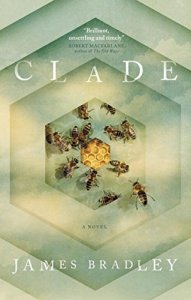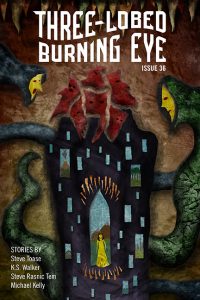Paul Di Filippo reviews James Bradley
Clade, by James Bradley (Titan 978-1785654145, $14.95, 320pp, trade paperback September 2017; Penguin Australia, January 2015)
 Clade is an irresistible title for a hardcore SF novel. I thought so in 2003 when a promising cyberpunk author named Mark Budz used it for his debut novel. (I ended up reviewing the subsequent well-done trilogy for Scott Edelman at SF Weekly. Alas, Budz has fallen silent since 2007.) I would stake a bet on the word’s prominence being solely attributable to Bruce Sterling, who popularized it in his Shaper/Mechanist stories. But whatever fueled its leap to the forefront of SF consciousness, it still retains a definite punchiness and allure. And since, of course, titles cannot be copyrighted, it’s well and good that after fourteen years the noun again graces a novel where biology is the dominant motif and science. However, unlike Budz’s radical biopunk take on the future, Bradley offers a quiet, humanist perspective, salted with climate-change themes. Its spiritual and tactical progenitors are such fine books as Kate Wilhelm’s Where Late the Sweet Birds Sang and Brian Aldiss’s Greybeard. But it’s also up-to-date in the manner of Matthew De Abaitua’s books.
Clade is an irresistible title for a hardcore SF novel. I thought so in 2003 when a promising cyberpunk author named Mark Budz used it for his debut novel. (I ended up reviewing the subsequent well-done trilogy for Scott Edelman at SF Weekly. Alas, Budz has fallen silent since 2007.) I would stake a bet on the word’s prominence being solely attributable to Bruce Sterling, who popularized it in his Shaper/Mechanist stories. But whatever fueled its leap to the forefront of SF consciousness, it still retains a definite punchiness and allure. And since, of course, titles cannot be copyrighted, it’s well and good that after fourteen years the noun again graces a novel where biology is the dominant motif and science. However, unlike Budz’s radical biopunk take on the future, Bradley offers a quiet, humanist perspective, salted with climate-change themes. Its spiritual and tactical progenitors are such fine books as Kate Wilhelm’s Where Late the Sweet Birds Sang and Brian Aldiss’s Greybeard. But it’s also up-to-date in the manner of Matthew De Abaitua’s books.
Our focus will be the Leith family of Sydney, Australia, in a day-after-tomorrow beginning that eventually leaps forward a few decades. Three generations will live through the manifold, multiplex changes which our civilization is inflicting on the planet. The oldest generation features Adam Leith, a scientist, and his wife Ellie, an artist. We get intimate glimpses of their courtship, their marriage, and their struggle to conceive a child through IVF. Of course, all of this takes place against a background of global greenhouse roiling that, at first, produces only mild inconveniences such as power brownouts. But the reader is advised to hold onto his or her hat for the rollercoaster ride ahead.
Eventually the couple has a daughter named Summer, who proves to be far from a placid, happy child. We watch her grow to a troubled adulthood, which coincides with massive weather-wrought disasters. She gives birth to a son named Noah, who develops from childhood as a smart but Asperger’s-hindered soul. Noah’s teen years include a catastrophic global pandemic. Ellie and Adam, separated, follow different vectors throughout these times. (Ellie’s interlude with Amir, a beekeeper, also rings in some hot-button issues of refugees and their treatment.) Eventually, with all four of our familial protagonists having survived, we enter a nascent recovery period that portends perhaps a better future for the species and the planet.
Now, in recounting the plot, and trying to avoid spoilers, I fear I have made it sound rather soap-opera-like. And it is true that large portions of the novel are devoted to naturalistic, well-wrought, finely nuanced renderings of emotions, personal interactions, societal duties, and the like. I was reminded of the prose and concerns of Christopher Barzak here. But this focus does not preclude tight speculative interweavings, all the more subtle for not dominating the discourse.
As a student he spent a summer living in England, and travelled this way more than once. Back then the flat fields and rows of hedges and houses always seemed like a reminder of another age, unaltered by the passage of time Even now much is the same, yet it is difficult to ignore the stands of genetically engineered trees that line the edges of fields, unnaturally tall against the remaining clumps of oak and pine. The most visible of the various organisms developed in the last decade or so to consume and store carbon dioxide, they have come to be known as triffids, a name that captures the unsettlingly alien blurring of plant and flesh suggested by their thick boles and distorted dimensions. But to Adam’s eyes what their smooth, slightly bulbous trunks and inverted canopies most resemble is the great baobabs that once grew in Madagascar.
When they were first developed many assumed the motivation was financial rather than ecological, citing as evidence the decision of the companies that created them to patent their genomes instead of making them available for free. Environmental groups fought their introduction hard, poisoning fields earmarked for their planting and burning plantations, but governments here and elsewhere held firm, arguing that the importance of capturing carbon dioxide far outweighed the risk of further contamination of ecosystems.
Unsurprisingly these assurances soon proved incorrect. Only months after the first plantations were established, triffids had begun to turn up along waterways and in forests across England and Scotland, a process that was repeated in other countries, one more factor in the ongoing transformation of the world’s ecosystems.
When he was younger he would have been on the side of the protesters, would have regarded the intrusion of these unnatural tropical creations into this landscape as a catastrophe. But looking at them now he finds himself wondering if they are not simply the latest stage in a process that goes back millennia. After all, these fields were once wetlands, a vast interconnected maze of low pools and streams and marshes stretching from Cambridge to the sea. Then, two hundred years ago, humans drained the land, constructing embankments and pumping the water out to sea to create space for farms and roads and forests. Wth the water gone the land changed. Fishing and fowling gave way to farming, farms to factories. Even the birds that congregated here began to disappear, some dying, others finding new breeding grounds, altering their migratory routes. And in their place the land itself took on new shapes.
This kind of semi-pastoral, poetic longview of change is what harkens me to Aldiss’s similar Greybeard. It’s a rare contemplative take on our transforming planet, different from, say, the nuts-and-bolts approach of Kim Stanley Robinson.
Further flavoring the domesticity of the book are several major set pieces that conjure up comparisons to classic disaster novels: Adam, Summer, and Noah in flooded England; Adam and Noah and a family friend hiding out from the pandemic. These touches elevate the book from any kind of weak-tea “mainstream SF” niche to the pure quill.
Bradley delivers his tale in relatively short, disjunctive sections that leapfrog across the years, making this book almost–but not precisely–a “novel told in short stories.” But the continuity is stronger than in such a fix-up and ultimately more productive of good emotional and thematic resonances.
Australia is a continent that will not be spared a climactic kick in the pants, and it’s useful to have this Down Under perspective on such events. George Turner’s Drowning Towers comes to mind as a reliable ancestor for this novel. In the final section, focused on several young adults of the new, transformed generation–the inheritor clade, if you will–we get a sense that perhaps humanity has begun to transcend a limitation which Adam has clearly expressed earlier, in terms familiar to anyone who has read John Brunner’s allied The Sheep Look Up.
“I don’t know. We keep talking about trying to stop what’s happening, slow it down somehow, but I’m not sure that’s even possible any more. Them are so many of us, and resources are stretched so thin the system can’t survive unless there’s some kind of radical change. The problem is we’re so busy stumbling from one disaster to the next we can’t get any distance, can’t see what’s happening for what it is.”
Novels like Clade provide the lens we need to see our way forward.





